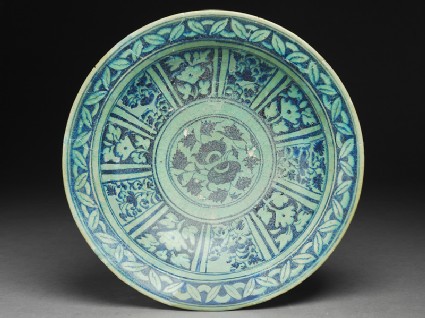Islamic Ceramics
A select catalogue of the Ashmolean's collection of ceramics from the Islamic world from the 9th to 18th century, by James Allen (published Oxford, 1991).

Publications online: 46 objects
- Reference URL
Actions
Dish with floral decoration in radial panels
-
Literature notes
The redevelopment of large areas of the old city of Damascus in the 1960’s brought to life many hundreds of pieces of Chinese porcelain, imported into Syria from the late fourteenth century onwards, and cherished by their owners over the centuries. Among these porcelains are dishes which show very clearly the Chinese origin of both the blue-and-white colour scheme, and some of the plant forms, on contemporary Syrian vessels and tiles.
Although precise dating of most blue-and-white Syrian objects may be difficult, the blue and white tiles which decorate the mausoleum and mosque of Ghars al-Din al-Khalil al-Tawrizi, vizier of Damascus, who died in 1430, show that the style was at its most popular in the second decade of the fifteenth century. Particular plant and leaf forms on the Tawrizi tiles in fact compare closely with those in the more densely decorated radiating panels on this dish, suggesting that a date of circa 1425 for the dish cannot be far from the truth. Typically Syrian are the form of a dish (a shallower version of the thirteenth century Syrian bowl form illustrated elsewhere), and the pattern on the rim, both of which are found in contemporary sgraffito wares. More unusual on Syrian blue-and-white is the turquoise glaze. Like the geometric layout, however it recalls yet again the way medieval Islamic potters were keen to move away from slavish copies of Chinese imports to designs which incorporated their own culture traditions and artistic taste.
In Iran the adoption of blue-and-white was destined to have a long and productive future. In the early sixteenth century, however, Syria became a mere province of the vast Ottoman Turkish empire. As a cultural backwater, its ceramics henceforward played second fiddle to the rich polychrome wares of Iznik, unable to emulate them in either design or colour. -
Details
- Associated place
- Date
-
15th century (1401 - 1500)
Timurid Period (1370 - 1507)
- Material and technique
- fritware, with painting in blue under a turquoise glaze
- Dimensions
-
8.5 cm (height)
30.4 cm (diameter)
at foot 10.2 cm (diameter)
- Material index
- Technique index
- Object type index
- No. of items
- 1
- Credit line
- Gift of Gerald Reitlinger, 1978.
- Accession no.
- EA1978.1608
-
Further reading
Allan, James W., Islamic Ceramics, Ashmolean-Christie's Handbooks (Oxford: Ashmolean Museum, 1991), no. 27 on p. 46, illus. p. 47
Golombek, Lisa, Robert B. Mason, and Gauvin A. Bailey, Tamerlane's Tableware: A New Approach to Chinoiserie Ceramics of Fifteenth- and Sixteenth-Century Iran, Islamic Art and Architecture, 6 (Costa Mesa, California: Mazda Publishers in Association with Royal Ontario Museum, 1996), pp. 42 (table 3.6) & 155, pls 33 a & b
Glossary (2)
fritware, glaze
-
fritware
Ceramic material composed of ground quartz and small quantities of clay and finely ground frit (frit is obtained by pouring molten glass into water).
-
glaze
Vitreous coating applied to the surface of a ceramic to make it impermeable or for decorative effect.
Location
Objects are sometimes moved to a different location. Our object location data is usually updated on a monthly basis. Contact the Jameel Study Centre if you are planning to visit the museum to see a particular object on display, or would like to arrange an appointment to see an object in our reserve collections.
Galleries
Publications online
-

Islamic Ceramics
The redevelopment of large areas of the old city of Damascus in the 1960’s brought to life many hundreds of pieces of Chinese porcelain, imported into Syria from the late fourteenth century onwards, and cherished by their owners over the centuries. Among these porcelains are dishes which show very clearly the Chinese origin of both the blue-and-white colour scheme, and some of the plant forms, on contemporary Syrian vessels and tiles.
Although precise dating of most blue-and-white Syrian objects may be difficult, the blue and white tiles which decorate the mausoleum and mosque of Ghars al-Din al-Khalil al-Tawrizi, vizier of Damascus, who died in 1430, show that the style was at its most popular in the second decade of the fifteenth century. Particular plant and leaf forms on the Tawrizi tiles in fact compare closely with those in the more densely decorated radiating panels on this dish, suggesting that a date of circa 1425 for the dish cannot be far from the truth. Typically Syrian are the form of a dish (a shallower version of the thirteenth century Syrian bowl form illustrated elsewhere), and the pattern on the rim, both of which are found in contemporary sgraffito wares. More unusual on Syrian blue-and-white is the turquoise glaze. Like the geometric layout, however it recalls yet again the way medieval Islamic potters were keen to move away from slavish copies of Chinese imports to designs which incorporated their own culture traditions and artistic taste.
In Iran the adoption of blue-and-white was destined to have a long and productive future. In the early sixteenth century, however, Syria became a mere province of the vast Ottoman Turkish empire. As a cultural backwater, its ceramics henceforward played second fiddle to the rich polychrome wares of Iznik, unable to emulate them in either design or colour.
Notice
Object information may not accurately reflect the actual contents of the original publication, since our online objects contain current information held in our collections database. Click on 'buy this publication' to purchase printed versions of our online publications, where available, or contact the Jameel Study Centre to arrange access to books on our collections that are now out of print.
© 2013 University of Oxford - Ashmolean Museum







